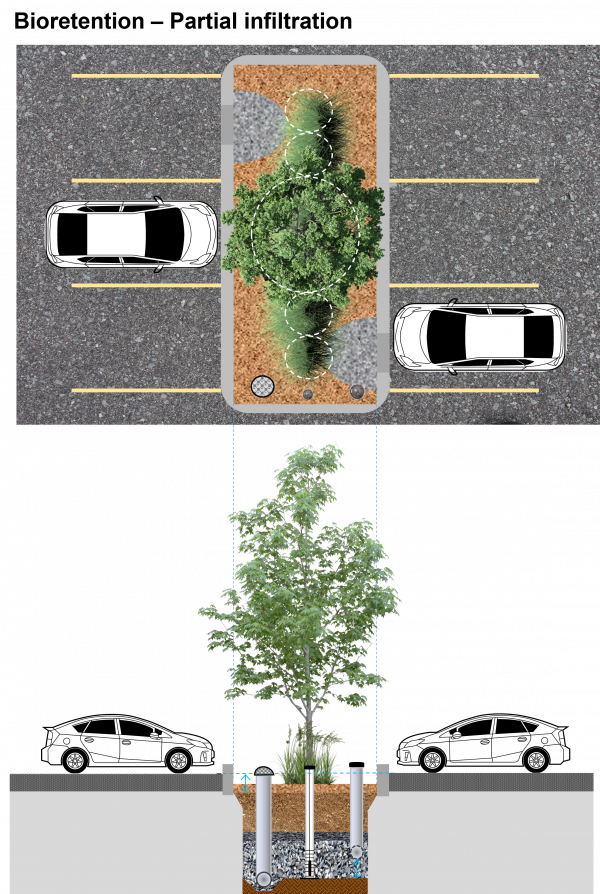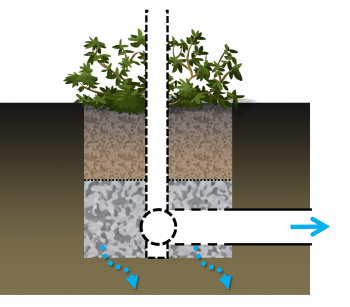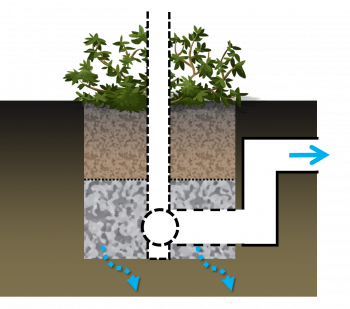Difference between revisions of "Bioretention: Partial infiltration"
Jump to navigation
Jump to search

| (4 intermediate revisions by the same user not shown) | |||
| Line 1: | Line 1: | ||
<imagemap> | <imagemap> | ||
| − | File:Bioretention Full Partial infiltration placementswap.png | + | File:Bioretention Full Partial infiltration placementswap.png|thumb|600px|'''Partial infiltration''' bioretention cell draining a parking lot. This design variation includes an underdrain and surface overflow pipes that allow excess water to leave the practice. A monitoring well is included so drainage performance can be evaluated over its operating lifespan. For more details on this variation of a bioretention feature and others, click here for the [https://www.toronto.ca/legdocs/mmis/2017/pw/bgrd/backgroundfile-107514.pdf City of Toronto's Green Streets Technical Guidelines (GSTG).],<ref>City of Toronto. 2017. City of Toronto's Green Streets Technical Guidelines - Version 1.0. Schollen & Company Inc., Urban Forest Innovators, TMIG, DMG. August, 2017. https://www.toronto.ca/legdocs/mmis/2017/pw/bgrd/backgroundfile-107514.pdf</ref> <span style="color:red">'''''Note''': The following is an "image map", feel free to explore the image with your cursor and click on highlighted labels that appear to take you to corresponding pages on the Wiki.''</span> |
| − | |thumb|600px|'''Partial infiltration''' bioretention cell draining a parking lot. This design variation includes an underdrain and surface overflow pipes that allow excess water to leave the practice. A monitoring well is included so drainage performance can be evaluated over its operating lifespan. For more details on this variation of a bioretention feature and others, click here for the [https://www.toronto.ca/legdocs/mmis/2017/pw/bgrd/backgroundfile-107514.pdf City of Toronto's Green Streets Technical Guidelines (GSTG).],<ref>City of Toronto. 2017. City of Toronto's Green Streets Technical Guidelines - Version 1.0. Schollen & Company Inc., Urban Forest Innovators, TMIG, DMG. August, 2017. https://www.toronto.ca/legdocs/mmis/2017/pw/bgrd/backgroundfile-107514.pdf</ref> <span style="color:red">'''''Note''': The following is an "image map", feel free to explore the image with your cursor and click on highlighted labels that appear to take you to corresponding pages on the Wiki.''</span> | ||
rect 1295 2828 1342 3128 [[Underdrains|Underdrain Access Structure]] | rect 1295 2828 1342 3128 [[Underdrains|Underdrain Access Structure]] | ||
rect 1296 1423 1348 1478 [[Underdrains|Underdrain Access Structure]] | rect 1296 1423 1348 1478 [[Underdrains|Underdrain Access Structure]] | ||
rect 1293 3128 1346 3178 [[Underdrains|Underdrain]] | rect 1293 3128 1346 3178 [[Underdrains|Underdrain]] | ||
| − | |||
rect 1134 3187 1159 3246 [[Digital technologies|Water Level Sensor]] | rect 1134 3187 1159 3246 [[Digital technologies|Water Level Sensor]] | ||
| + | rect 1112 3181 1169 3250 [[Bioretention: Internal water storage|Internal Water Storage]] | ||
rect 1126 2838 1163 3187 [[Wells|Monitoring Well]] | rect 1126 2838 1163 3187 [[Wells|Monitoring Well]] | ||
rect 1116 1437 1163 1480 [[Wells|Monitoring Well]] | rect 1116 1437 1163 1480 [[Wells|Monitoring Well]] | ||
| − | rect 1295 3183 1348 3254 [[Bioretention|Water Storage | + | rect 1295 3183 1348 3254 [[Bioretention: Internal water storage|Internal Water Storage]] |
rect 939 1415 1011 1482 [[Overflow|Overflow Outlet]] | rect 939 1415 1011 1482 [[Overflow|Overflow Outlet]] | ||
rect 956 2845 1017 3177 [[Overflow|Overflow Outlet]] | rect 956 2845 1017 3177 [[Overflow|Overflow Outlet]] | ||
| Line 41: | Line 40: | ||
rect 1023 3114 1113 3189 [[Reservoir aggregate|Clear Stone / Aggregate]] | rect 1023 3114 1113 3189 [[Reservoir aggregate|Clear Stone / Aggregate]] | ||
rect 1170 3116 1388 3191 [[Reservoir aggregate|Clear Stone / Aggregate]] | rect 1170 3116 1388 3191 [[Reservoir aggregate|Clear Stone / Aggregate]] | ||
| − | rect 1045 3252 1363 3309 [[Soil | + | rect 1045 3252 1363 3309 [[Soil Groups|Compacted Subgrade Soil]] |
| − | rect 900 3289 1047 3309 [[Soil | + | rect 900 3289 1047 3309 [[Soil Groups|Compacted Subgrade Soil]] |
</imagemap> | </imagemap> | ||
| Line 65: | Line 64: | ||
*[[Erosion control blankets|Erosion control]] | *[[Erosion control blankets|Erosion control]] | ||
*[[Mulch]] | *[[Mulch]] | ||
| − | *[[ | + | *[[Planting design|Planting considerations]] and [[Plant lists| Recommended species]] |
| − | |||
| − | |||
{{Clickable button|[[Bioretention cells|Back to Bioretention]]}} | {{Clickable button|[[Bioretention cells|Back to Bioretention]]}} | ||
| + | |||
| + | ==References== | ||
[[category: Infiltration]] | [[category: Infiltration]] | ||
Latest revision as of 20:25, 27 September 2022

Partial infiltration bioretention cell draining a parking lot. This design variation includes an underdrain and surface overflow pipes that allow excess water to leave the practice. A monitoring well is included so drainage performance can be evaluated over its operating lifespan. For more details on this variation of a bioretention feature and others, click here for the City of Toronto's Green Streets Technical Guidelines (GSTG).,[1] Note: The following is an "image map", feel free to explore the image with your cursor and click on highlighted labels that appear to take you to corresponding pages on the Wiki.
Overview[edit]
Over soils with slow infiltration rates, it is advantageous to drain a portion of the stored water prior to any upcoming storm. This popular design choice can optimize annual water balance, mitigate peak flow rates and by ensuring water flow through, can reduce the accumulation of sodium and chlorine ions from winter salting.
Partially infiltrating bioretention with underdrain.
Partially infiltrating bioretention with anaerobic/aerobic storage zone.
Materials[edit]
References[edit]
- ↑ City of Toronto. 2017. City of Toronto's Green Streets Technical Guidelines - Version 1.0. Schollen & Company Inc., Urban Forest Innovators, TMIG, DMG. August, 2017. https://www.toronto.ca/legdocs/mmis/2017/pw/bgrd/backgroundfile-107514.pdf

